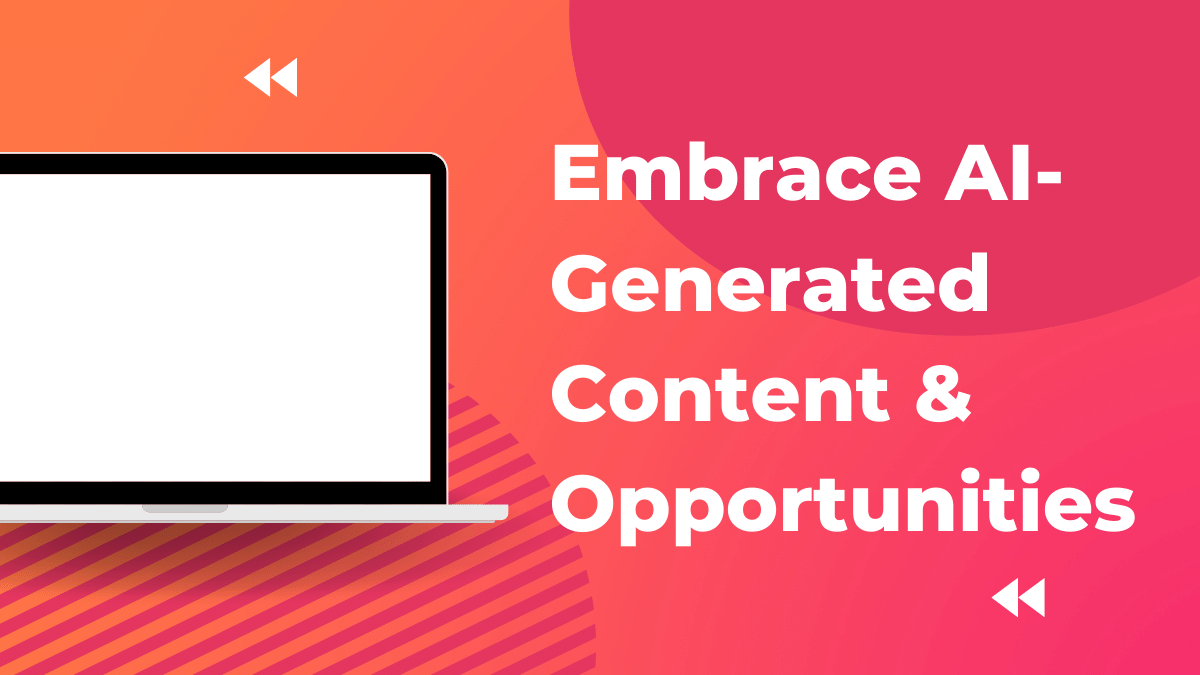SEO
3 Exciting Ways To Safely Embrace AI-Generated Content & Opportunities
Artificial Intelligence (AI) has rapidly transformed various industries, and the field of content creation is no exception. AI-generated content offers exciting opportunities for businesses and content creators alike. By leveraging AI tools and techniques, companies can enhance their productivity, streamline content creation processes, and unlock new possibilities. However, it is essential to approach AI-generated content with caution and ensure its safe and responsible implementation. In this article, we will explore three exciting ways to embrace AI-generated content while maintaining quality, authenticity, and ethical standards.
Table of Contents
- Introduction: The Rise of AI-Generated Content
- Enhancing Creativity and Efficiency
- Leveraging AI for Content Ideation
- Streamlining Content Creation Processes
- Optimizing Content Distribution
- Ensuring Authenticity and Quality
- Human Supervision and Editing
- Establishing Guidelines and Parameters
- Incorporating User Feedback
- Ethical Considerations and Responsible Use
- Transparency and Disclosure
- Safeguarding Against Bias and Discrimination
- Respect for Intellectual Property Rights
- Conclusion
- FAQs
1. Introduction: The Rise of AI-Generated Content
With advancements in machine learning and natural language processing, AI has become increasingly proficient in generating content. From automated article writing to chatbots and virtual assistants, AI-powered systems are capable of producing text that closely resembles human-generated content. This shift has opened up a range of possibilities for businesses seeking to optimize their content creation processes and engage their audience more effectively.
2. Enhancing Creativity and Efficiency
Leveraging AI for Content Ideation
AI tools can provide valuable insights and suggestions for content ideas. By analyzing vast amounts of data and user behavior patterns, AI algorithms can identify trending topics, keywords, and target audience preferences. This information can guide content creators in crafting compelling and relevant articles, blog posts, and other forms of content.
Streamlining Content Creation Processes
AI-generated content can significantly improve efficiency and productivity. Content creators can utilize AI-powered tools to automate repetitive tasks such as grammar and spell checking, formatting, and fact-checking. This enables them to focus more on the creative aspects of content creation and produce high-quality work at a faster pace.
Optimizing Content Distribution
AI algorithms can analyze user behavior and engagement metrics to optimize content distribution strategies. By identifying the most effective channels, timing, and targeting options, AI-generated insights can help content creators maximize the reach and impact of their content. This data-driven approach ensures that content is delivered to the right audience at the right time, resulting in increased visibility and engagement.
3. Ensuring Authenticity and Quality
Human Supervision and Editing
While AI-generated content offers numerous advantages, it is crucial to involve human supervision and editing in the process. Human reviewers can ensure that the content aligns with the brand’s voice, tone, and style guidelines. They can also add a personal touch and critical thinking to enhance the quality and authenticity of the content.
Establishing Guidelines and Parameters
To maintain control over AI-generated content, it is essential to establish clear guidelines and parameters. Content creators should define the boundaries within which AI algorithms operate and ensure they align with ethical standards. By providing specific instructions and setting constraints, content creators can avoid potential pitfalls and maintain the desired level of quality.
Incorporating User Feedback
User feedback plays a vital role in refining and improving AI-generated content. Collecting feedback from readers and incorporating their suggestions allows content creators to adapt and optimize their AI models. This iterative process ensures that the content remains relevant, engaging, and aligned with the preferences of the target audience.
4. Ethical Considerations and Responsible Use
Transparency and Disclosure
When utilizing AI-generated content, transparency and disclosure are paramount. It is crucial to clearly communicate to the audience that the content has been generated or assisted by AI systems. This transparency builds trust and establishes a level of authenticity with the readers. Users should be aware of the involvement of AI in the content creation process.
Safeguarding Against Bias and Discrimination
AI algorithms can inadvertently perpetuate biases present in the training data. To ensure fairness and prevent discrimination, content creators must carefully evaluate and address any potential biases in AI-generated content. Regular monitoring, testing, and fine-tuning of the AI models can help mitigate bias and ensure inclusivity.
Respect for Intellectual Property Rights
When utilizing AI-generated content, it is essential to respect intellectual property rights. Content creators should ensure that the AI algorithms do not infringe upon copyright or plagiarism laws. By incorporating proper attribution and adhering to legal and ethical standards, businesses can maintain a strong reputation and avoid legal complications.
5. Conclusion
AI-generated content presents exciting opportunities for businesses and content creators. By leveraging AI tools and techniques, companies can enhance their creativity, streamline content creation processes, and optimize content distribution. However, it is crucial to approach AI-generated content responsibly. Incorporating human supervision, establishing guidelines, and ensuring ethical considerations are essential for maintaining authenticity, quality, and user trust.
FAQs
Q1: Can AI-generated content replace human content creators? AI-generated content can automate certain aspects of content creation, but it cannot replace the creativity and critical thinking abilities of human content creators. Humans bring a unique perspective, empathy, and emotional intelligence to content creation, which AI systems currently lack.
Q2: How can AI-generated content be monitored for quality and accuracy? Human supervision and editing play a crucial role in monitoring the quality and accuracy of AI-generated content. Content creators should have a thorough review process in place to ensure that the content aligns with the brand’s standards and maintains a high level of accuracy.
Q3: What are the potential risks associated with AI-generated content? AI-generated content may carry risks such as unintended biases, errors, or lack of context. It is essential to carefully evaluate and address these risks to ensure the content’s overall quality, authenticity, and user experience.
Q4: How can businesses maintain a balance between AI-generated and human-generated content? Businesses can maintain a balance by identifying the tasks that can be effectively automated using AI-generated content and those that require human creativity and expertise. By strategically allocating resources and leveraging the strengths of both approaches, businesses can create a harmonious content creation process.
Q5: What are the key considerations for businesses adopting AI-generated content? Businesses should prioritize transparency, ethical use, and respect for intellectual property rights when adopting AI-generated content. They should also continuously monitor and evaluate the content’s impact and user feedback to make informed adjustments and improvements.

